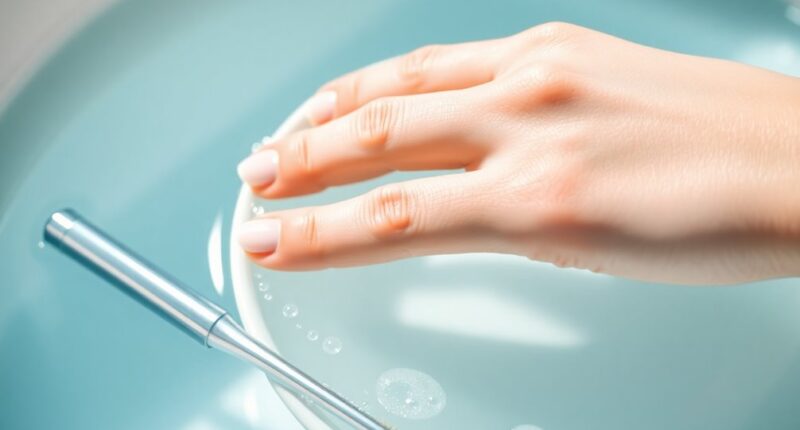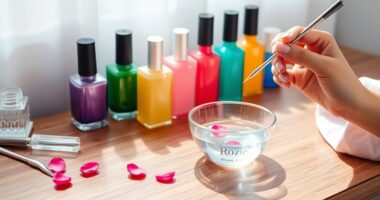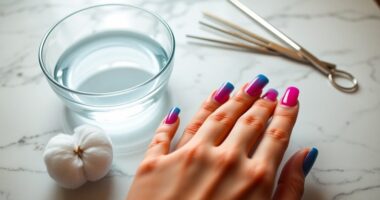To clean under your nails, start by washing your hands with soap and water for at least 20 seconds. Use a soft nail brush to scrub gently, focusing on the underside. An orangewood stick can help remove stubborn debris without damaging your skin. Always sanitize your tools before use to prevent infections. After cleaning, consider applying cuticle oil for added hydration. If you want to learn about additional nail care tips and techniques, keep going!
Key Takeaways
- Use a soft nail brush to gently scrub under the nails, removing dirt and debris effectively.
- Soak your nails in warm water mixed with apple cider vinegar to loosen stubborn grime.
- Utilize an orangewood stick to carefully clean under the nails without damaging the surrounding skin.
- Wash your hands thoroughly with soap and water for at least 20 seconds before and after cleaning.
- Regularly trim nails every two weeks to prevent dirt accumulation and maintain hygiene.
Understanding Nail Hygiene
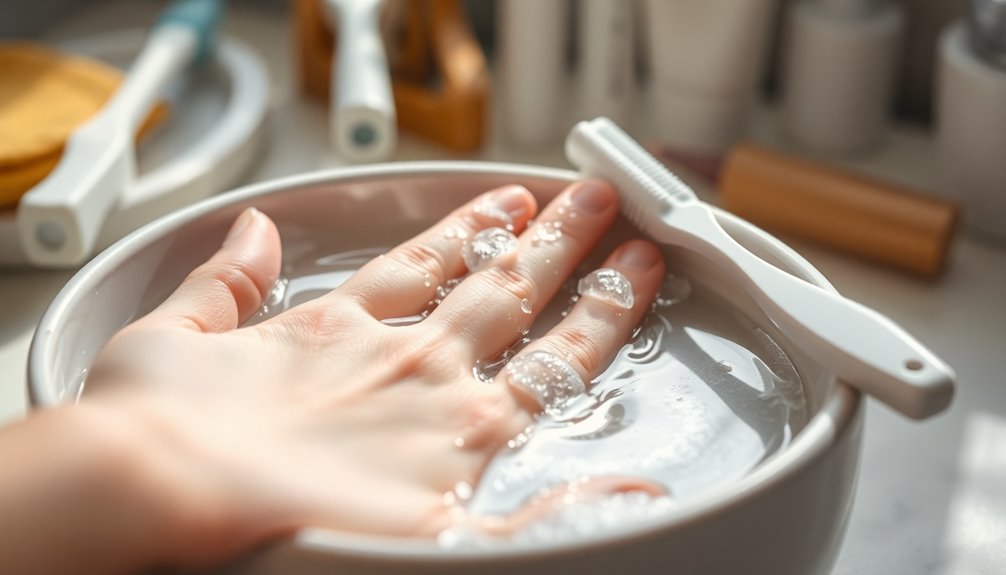
When you neglect to clean under your nails, dirt and bacteria can build up, leading to potential infections.
It's crucial to understand nail hygiene to maintain your overall health. Accumulated pathogens can easily transfer from your nails to other body parts, increasing infection risks.
To keep your nails healthy, make it a habit to clean underneath them regularly. Using a soft nail brush and soap during handwashing is an effective way to remove debris and minimize harmful microorganisms.
Additionally, soaking your nails in clean water mixed with apple cider vinegar can help dislodge stubborn dirt while offering antibacterial properties. Regular cleaning of the cage is essential to prevent odor and disease, just as maintaining nail hygiene is important for overall health.
Prioritizing nail hygiene not only prevents infections but also promotes healthier nails and skin, enhancing your personal hygiene routine.
Tools You Need for Cleaning Nails
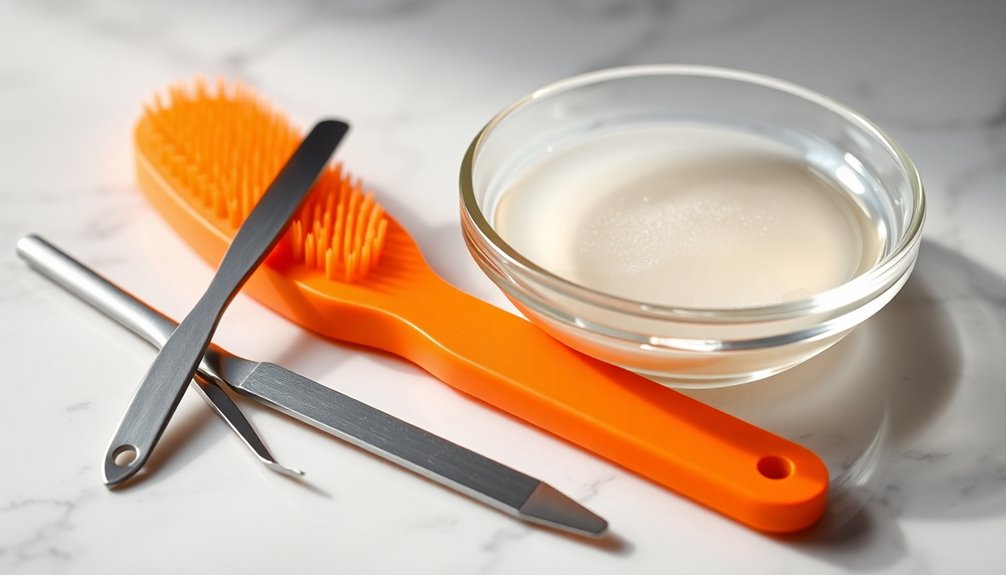
Maintaining nail hygiene requires the right tools to effectively clean under your nails. Start with a soft nail brush; it's essential for scrubbing away dirt and bacteria during handwashing.
An orangewood stick is another must-have—it gently cleans without damaging the sensitive skin around your nails. While a toothbrush can work, a smaller precision brush is often better for those tight spots.
Nail clippers are handy for trimming hangnails, which helps prevent dirt from accumulating under your nails.
Finally, remember to sanitize all your nail tools before use to minimize the risk of spreading germs and infections. Additionally, keeping your nails short can help reduce the risk of bacteria and dirt buildup, similar to the importance of wearing protective clothing when engaging in outdoor activities. Keeping these tools on hand will guarantee your nails stay clean and healthy.
The Importance of Regular Cleaning
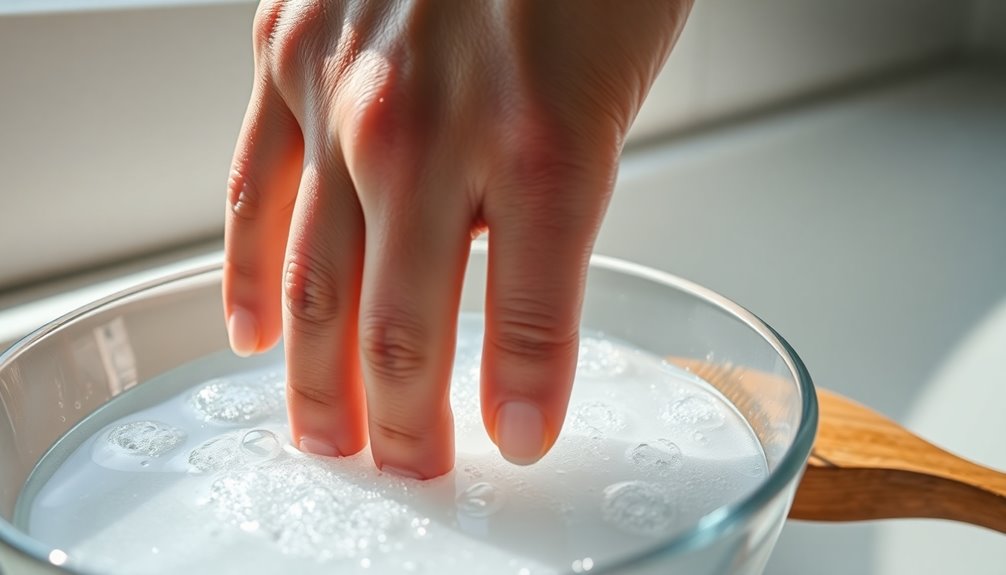
Hygiene is essential for overall health, and regular cleaning under your nails plays an important role in this. Dirt and bacteria can accumulate, increasing the risk of infections. Studies by the CDC show that clean nails host fewer pathogens, reducing the chances of nail infections and illnesses. Additionally, regular cleaning of your nails can help you maintain a healthy lifestyle.
| Benefit of Regular Cleaning | Impact on Health |
|---|---|
| Reduces risk of infections | Minimizes pathogen spread |
| Prevents discoloration | Maintains nail appearance |
| Avoids fungal infections | Promotes overall well-being |
Keeping your nails clean and well-groomed is crucial, especially if you have longer nails. Regular cleaning minimizes the risk of infections, ensuring your nails contribute positively to your health.
How to Properly Clean Under Your Nails

Regular cleaning under your nails is a straightforward process that can greatly enhance your overall health.
Start by washing your hands with soap and water for at least 20 seconds, making sure to scrub under your nails to minimize bacterial buildup.
To effectively clean under nails, use an orangewood stick or a soft nail brush to gently remove dirt and debris without damaging the delicate skin.
It's best to avoid sharp tools, as they can cause injury and increase infection risk.
If grime is stubborn, soak your nails in a mixture of equal parts clean water and apple cider vinegar for about 20 minutes.
After cleaning, dry your nails thoroughly and consider applying cuticle oil for added hydration. Additionally, maintaining healthy nail hygiene can prevent the buildup of harmful bacteria and promote overall well-being.
DIY Nail Soak Recipes
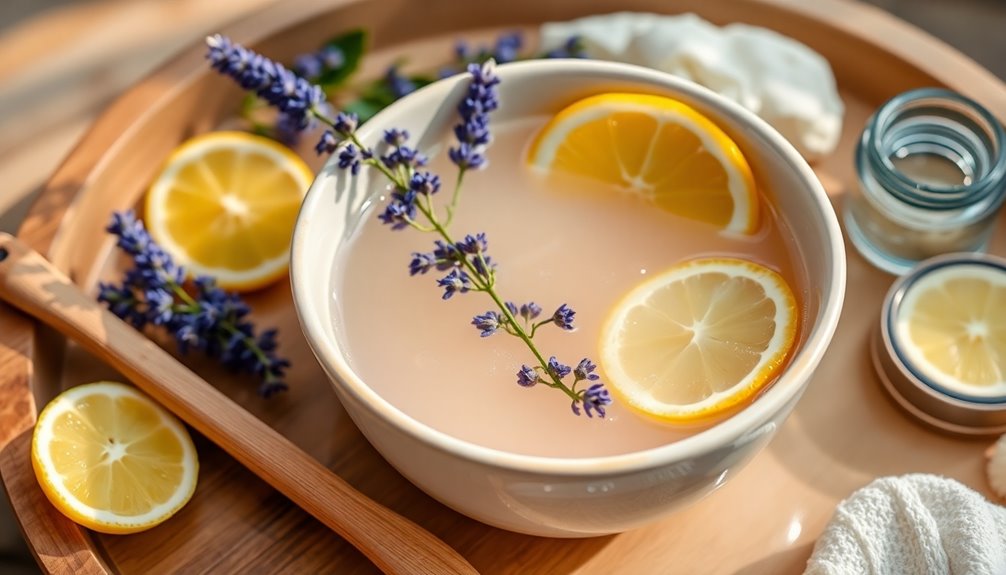
If you want to give your nails a thorough clean, creating a DIY nail soak is a great place to start.
You can choose from various effective ingredients and techniques that not only clean but also nourish your nails. Incorporating essential oils like eucalyptus oil can enhance the cleaning process and provide additional benefits for your nails.
With the right soaking duration, you'll enjoy the benefits of healthier, cleaner nails in no time.
Effective Soaking Ingredients
Creating an effective DIY nail soak can transform your nail-cleaning routine with just a few simple ingredients.
Mix equal parts warm water and apple cider vinegar to loosen dirt and kill bacteria, softening your nails for easier cleaning. Honey is another effective soaking ingredient; its natural antibacterial and antifungal properties help maintain healthy nails.
For added cleaning power, include a few drops of dish soap to break down oil and grime trapped under your nails. You can also enhance your soak with essential oils like tea tree or lavender, which offer antimicrobial benefits and a pleasant scent. Using essential oils can improve indoor air quality while you soak, making your nail care routine more refreshing.
This combination will leave your nails cleaner and healthier, making your nail care routine more effective and enjoyable.
Soaking Duration and Techniques
Soaking your nails effectively is key to achieving a deep clean and maintaining healthy nails. For ideal results, utilize a soak for about 20 minutes in a mixture of equal parts clean water and apple cider vinegar to loosen dirt and bacteria. If you prefer a DIY option, mix honey with warm water for its antibacterial properties. For tougher grime, warm water with mild soap works wonders. Remember to verify your nails are dry before soaking, as this helps in the cleaning process. After soaking, gently scrub with an orangewood stick to remove any remaining debris. Additionally, keeping your nails hydrated can support fetal development during pregnancy.
| Soak Mixture | Soaking Duration | Purpose |
|---|---|---|
| Water & Apple Cider Vinegar | 20 minutes | Loosen dirt and bacteria |
| Honey & Warm Water | 15-20 minutes | Antibacterial enhancement |
| Warm Water & Mild Soap | 10-15 minutes | Break down tough grime |
Benefits of Nail Soaks
While you mightn't realize it, incorporating nail soaks into your routine offers a range of benefits that go beyond mere cleanliness.
DIY nail soaks effectively loosen dirt and debris under your nails, making it easier to clean without irritating your skin. For a disinfecting boost, soak your nails in equal parts clean water and apple cider vinegar to tackle stubborn buildup.
Adding honey not only combats bacteria and fungus but also moisturizes your nails and surrounding skin, enhancing overall nail care. A gentle soak with soap or disinfectant cleans thoroughly while minimizing nail damage.
Regular use of nail soaks improves hygiene and appearance, leading to healthier nails and reducing the risk of infections from trapped dirt and bacteria. Additionally, maintaining healthy nails is crucial for overall nail appearance and strength.
Common Mistakes to Avoid
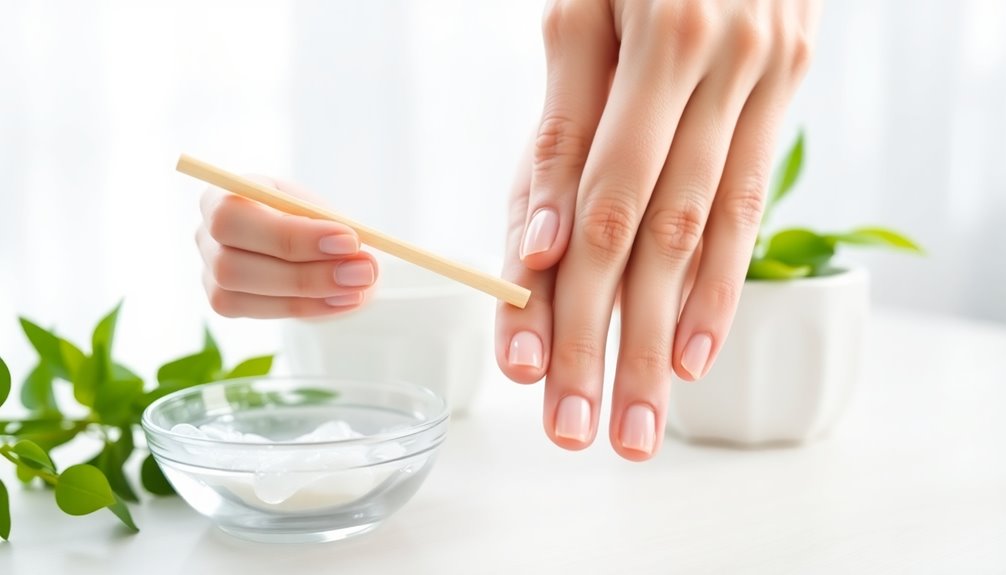
When it comes to cleaning under your nails, there are some common mistakes you should steer clear of.
Forgetting to sanitize your nail tools can lead to infections, while over-buffing your nails or neglecting your cuticles can cause unnecessary damage. Regular cleaning is essential for optimal performance to keep your nails healthy and clean.
Stay mindful of these pitfalls to keep your nails healthy and clean.
Ignoring Nail Tools Sanitation
Neglecting to sanitize your nail tools can lead to serious health issues, as bacteria and fungi thrive on dirty implements. Regularly disinfect your nail clippers, files, and brushes with alcohol or disinfectant before and after each use. Sharing tools without proper sanitation can transfer harmful bacteria, increasing infection risk.
| Tool | Sanitation Method |
|---|---|
| Nail Clippers | Wipe with alcohol wipes |
| Nail Files | Soak in disinfectant |
| Brushes | Rinse with hot water |
Failing to clean between uses allows keratin debris and skin cells to accumulate, making infections more likely. Using dirty tools can worsen existing nail conditions, allowing bacteria to infiltrate small cuts or breaks in your skin. Regular sanitation of tools is crucial, just as hearing aids require proper maintenance to ensure optimal performance and hygiene.
Over-Buffing Nail Surface
Over-buffing your nails can lead to significant damage, so it's crucial to approach this step of your nail care routine with caution.
When you over-buff the nail surface, you risk thinning and weakening your nails, making them more susceptible to breakage and splits. Excessive buffing can also dull your nails, robbing them of their natural shine and healthy appearance.
Additionally, buffing too aggressively may irritate the nail bed and surrounding skin, increasing the chances of infections and discomfort.
To protect your nails, buff gently and limit how often you do it. Always use a gentle buffer instead of a high-grit tool to prevent compromising your nail integrity and health.
Take care of your nails, and they'll thank you!
Improper Cuticle Care
Improper cuticle care can lead to a host of problems, including infections and damaged nail beds. One common mistake you might make is cutting your cuticles. This can break the protective barrier around your nails and increase the risk of infection.
Instead, focus on gently pushing them back without aggression, as too much pressure can irritate the skin. Always verify your tools are sanitized to minimize bacteria spread.
Regularly applying moisturizing cuticle oil or cream keeps your cuticles hydrated and prevents dryness.
Finally, be mindful of hangnails; don't tear them. Instead, trim them carefully with sanitized nail clippers to avoid injury.
Tips for Maintaining Nail Health
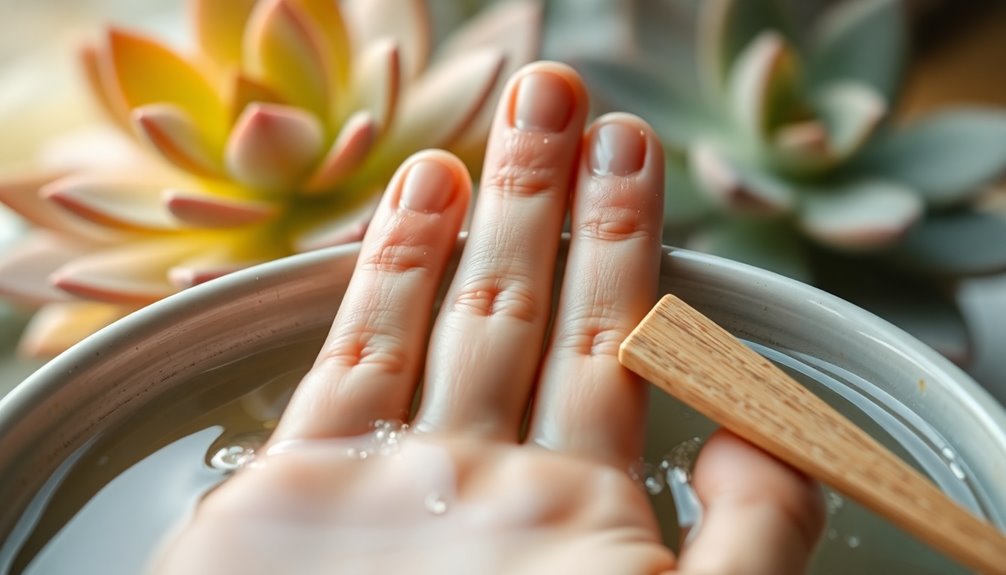
To maintain healthy nails, it's essential to adopt a consistent care routine. Regular cleaning under your nails with an orangewood stick helps remove dirt without harming your skin. Keep your nails trimmed short to prevent dirt buildup and minimize infection risks. Wash your hands frequently with warm, soapy water for at least 20 seconds to eliminate germs. Use gentle pressure while cleaning to avoid irritation. Additionally, soaking your nails in equal parts water and apple cider vinegar for 20 minutes can help lift stubborn dirt and boost overall nail health.
| Action | Frequency | Benefit |
|---|---|---|
| Clean under nails | Weekly | Prevents dirt accumulation |
| Trim nails | Every two weeks | Reduces infection risk |
| Wash hands | Daily | Maintains hygiene |
| Soak nails | Monthly | Improves nail health |
Signs of Nail Infections
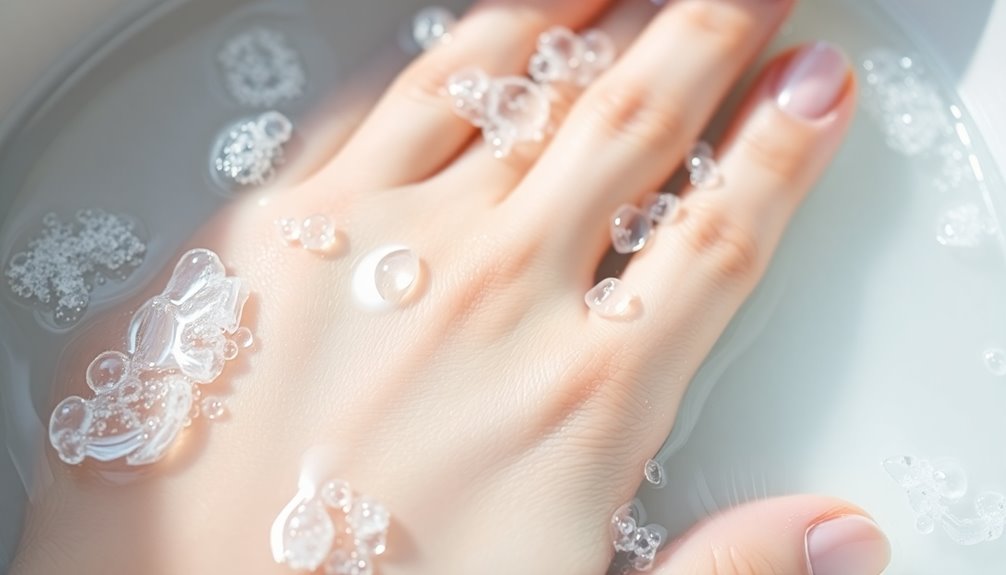
Even with a solid nail care routine, you might still encounter issues like infections.
Nail infections can show up in various ways. Look out for discoloration; greenish or yellowish hues often indicate bacterial growth underneath the nail.
You may also experience pain and swelling around the nail bed, which should prompt you to seek medical attention.
Foul odors coming from your nails can signal the presence of bacteria or fungi, indicating an infection that needs treatment.
Additionally, if you notice pus or fluid accumulating under the nail, it's a clear sign that you require professional help.
Changes in nail texture, such as brittleness or separation from the nail bed, can also suggest an underlying infection you shouldn't ignore.
Nail Care for Different Nail Types

When it comes to nail care, understanding your nail type is essential.
Short nails require regular trimming and cleaning to prevent dirt buildup, while long nails need careful maintenance to minimize bacteria.
If you use artificial nails, you'll want to adopt specific hygiene practices to keep them looking great and free from damage.
Short Nail Care
Although short nails may seem easier to maintain, they still require regular care to keep them clean and healthy.
To prevent dirt and bacteria from accumulating underneath your nails, wash your hands frequently with warm, soapy water—especially after activities that may introduce grime.
Using a soft nail brush or an orangewood stick allows you to clean under short nails effectively without damaging the delicate skin.
Keeping your nails trimmed and filed helps prevent dirt from getting trapped, reducing the risk of infections.
Additionally, regularly applying cuticle oil not only promotes healthy nail growth but also keeps nails clean by preventing hangnails, which can harbor dirt.
With these tips, you'll maintain the cleanliness and health of your short nails effortlessly.
Long Nail Maintenance
Maintaining long nails requires consistent attention to keep them clean and healthy. Regular cleaning prevents dirt and bacteria buildup, reducing the risk of infections and discoloration.
Use a soft nail brush or an orangewood stick to gently clean under your nails; just be careful not to apply too much pressure, as it can irritate your skin. Keeping your nails trimmed to a manageable length minimizes debris trapping.
To enhance nail health, apply cuticle oil regularly, promoting hydration and strength. If you encounter stubborn dirt, soak your nails in a warm water and soap solution or apple cider vinegar before brushing.
This method helps you keep your nails clean and looking great while maintaining their integrity.
Artificial Nail Hygiene
Caring for artificial nails requires special attention to hygiene, as they can create tiny spaces where bacteria may thrive. To keep your nails healthy, always wash your hands with warm, soapy water before and after cleaning under your artificial nails. Use a gentle orangewood stick or a soft brush to remove any debris without causing damage. Regular maintenance is key to preventing discoloration and buildup. Remember to sanitize your tools to avoid cross-contamination.
| Cleaning Step | Action |
|---|---|
| Step 1 | Wash your hands |
| Step 2 | Use a gentle stick or brush |
| Step 3 | Clean under the nails |
| Step 4 | Sanitize cleaning tools |
| Step 5 | Wash your hands again |
Enhancing Nail Aesthetics While Maintaining Hygiene
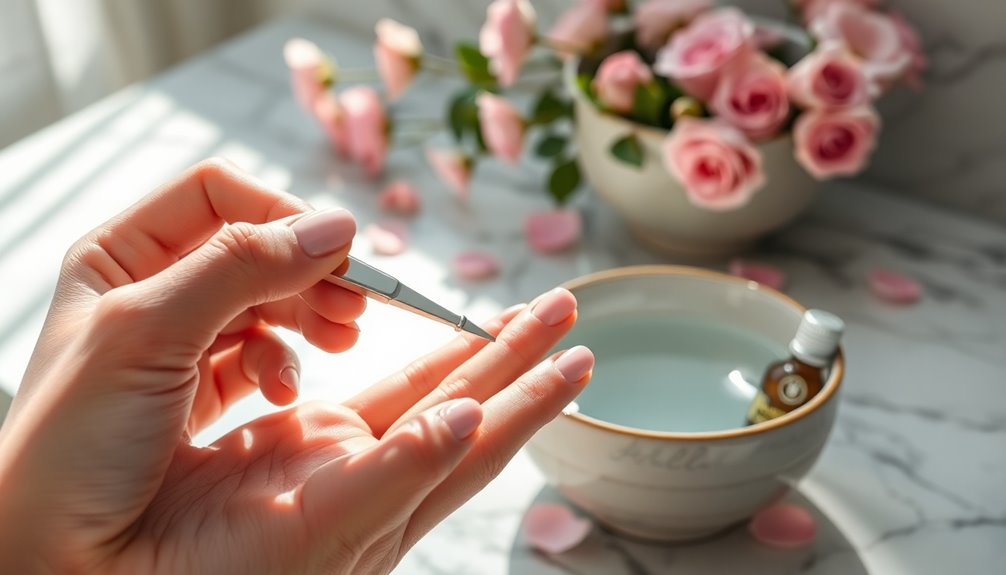
To enhance the aesthetics of your nails while guaranteeing they stay hygienic, it's vital to adopt a regular cleaning routine.
Start by using an orangewood stick or a soft nail brush to clean underneath your nails, removing dirt and debris for a polished look. Keeping your nails trimmed short not only reduces bacteria buildup but also gives them a refined appearance.
After cleaning, apply moisturizing cuticle oil to improve nail health and shine, making them less prone to breakage. If you enjoy nail polish or art, verify your nails are clean and healthy underneath to avoid infections that can ruin the look.
Consider a DIY soak with honey for gentle cleansing and antibacterial properties, promoting both hygiene and beauty.
Frequently Asked Questions
What Is the Best Way to Clean Under Your Fingernails?
To keep your fingernails clean, you should regularly scrub them during handwashing with soap and water for at least 20 seconds.
Use an orangewood stick or a soft nail brush to gently remove any debris without harming your skin.
Soaking your nails in a mix of water and apple cider vinegar can help loosen stubborn dirt.
Remember to avoid sharp tools, as they can cause injuries and lead to infections.
What Is the Thing That Cleans Under Your Nails?
You might think your nails are just decorative, but they actually collect all sorts of hidden treasures.
To clean under your nails, you can use a gentle orangewood stick, which works wonders without causing damage. A soft nail brush is great for scrubbing while washing your hands.
For stubborn dirt, try soaking your nails in water mixed with apple cider vinegar. Just remember, regular cleaning keeps everything fresh and healthy!
Why Do the Underside of My Nails Get Dirty?
The underside of your nails gets dirty for several reasons. Everyday activities expose your nails to dirt, oil, and food particles, especially if you've been gardening or cooking.
Personal care products can also leave behind buildup, leading to discoloration. If your nails are longer, they'll trap even more debris and bacteria.
Regular handwashing and nail care are essential to keep your nails clean and prevent dirt accumulation from affecting your hygiene.
What Is the Brown Gunk Under My Nails?
You might think the brown gunk under your nails is a secret treasure trove, but it's really just a mix of keratin debris, dirt, and skin cells!
If you don't clean regularly, this buildup can become a breeding ground for bacteria. Lotions and food can also trap particles beneath your nails.
Keeping your nails short and washing them often can help you avoid this unsightly mess and keep your hands looking great!
Conclusion
Just like a gardener tends to their flowers, nurturing your nails cultivates both beauty and health. By embracing regular cleaning and proper care, you're ensuring your nails flourish, free from the weeds of dirt and grime. Picture each clean nail as a petal in a vibrant bouquet, reflecting your attention to detail. As you maintain this garden, you'll not only enhance your aesthetic but also protect against hidden pests, ensuring your hands remain a masterpiece of hygiene and elegance.
